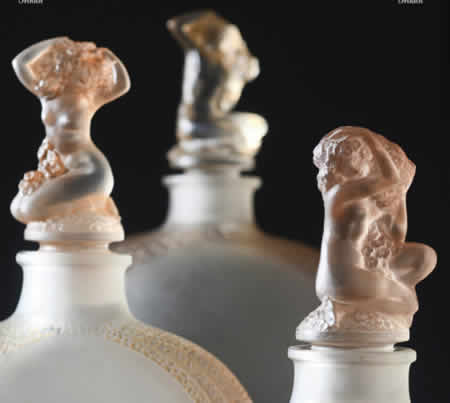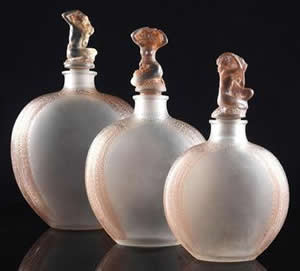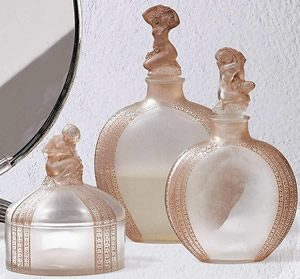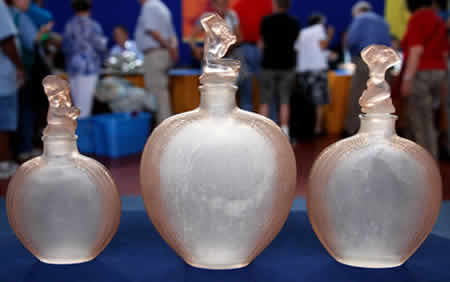Rene Lalique created several different Garnitures De Toilette (dresser, dressing table, or bathroom sets). The earliest set was created in 1909, with the most prevalent models following in 1919 and 1920 when Fleurettes and Epines were introduced just in time for the roaring 20’s. In the mid 1920’s Perles would make its appearance, and in 1931 Dahlia, Duncan and Enfants would appear in swift succession. Finally during the war years, Helene’s two bottles and one box debuted in 1942.

But the most visually stunning, the set with the largest bottles, and the only one of all the Garnitures to feature nude figures would come in 1928! Just three bottles and one covered box. Their name derives from the Greek word for “mouse ear”, the name given to a plant genus with over 200 varieties; so named because of the shape of the leafs which surround the small, usually less than a centimeter wide typically five lobed flowers. The flowering plant exists in Europe and in places as far away as New Zealand and Alaska (where one variety is the state flower).
 The plant is the stuff of legends in Germany, where one legend has it that when God named all the plants, a small genus cried out, Forget-me-not, O Lord! And God replied by naming the plant just that. A bit closer to our time, in the 1400’s in Germany, it was commonly held that if someone wore the flower from this plant, their lovers would not forget them! In 1926 it was adopted as an emblem by the German Freemasons as a message not to forget the needy (Das Vergissmeinnicht), and was likewise adopted by other charitable groups in Germany and elsewhere. It’s also rumored that the Freemasons used it during the Nazi era in Germany in substitution for their typical square and compass symbol as a secret outward means of identification when the Nazis began confiscating Freemason property.
The plant is the stuff of legends in Germany, where one legend has it that when God named all the plants, a small genus cried out, Forget-me-not, O Lord! And God replied by naming the plant just that. A bit closer to our time, in the 1400’s in Germany, it was commonly held that if someone wore the flower from this plant, their lovers would not forget them! In 1926 it was adopted as an emblem by the German Freemasons as a message not to forget the needy (Das Vergissmeinnicht), and was likewise adopted by other charitable groups in Germany and elsewhere. It’s also rumored that the Freemasons used it during the Nazi era in Germany in substitution for their typical square and compass symbol as a secret outward means of identification when the Nazis began confiscating Freemason property.
 Thoreau (“the mouse ear forget me not…”) and other writers of the 19th and 20th centuries incorporated it into the classic literature of our upbringing. And in 1928, Rene Lalique adopted it as the design motif for the Garniture he named after that same flowering plant: Myosotis. It’s French for “forget-me-not”!
Thoreau (“the mouse ear forget me not…”) and other writers of the 19th and 20th centuries incorporated it into the classic literature of our upbringing. And in 1928, Rene Lalique adopted it as the design motif for the Garniture he named after that same flowering plant: Myosotis. It’s French for “forget-me-not”!
The three different sized flask style bottles are each trimmed on the sides in Myosotis, as is the base and cover of the matching box. All four pieces have a different figure on top **; the bottles as the stopper decoration, and the box incorporated into the center of the top of the lid for easy handling.
The bottles range in height from 23 to 29 centimeters, and the box is 16 cm tall.*** All four models are hard to find in good condition today. The reasons for this include the relative high cost of the bottles when originally marketed in the late 20’s and throughout much of the 1930’s, so huge numbers were not sold; the fact that they were introduced just before the depression which had an obvious negative effect on sales all the way up to the start of World War II; and the fact that the large size and narrow flask shape of the bottles made it easy to knock them over, and made it likely that just one fall would do great and irreparable damage.
 Finally, as with other large nude stoppered pieces such as the vases Douze Figurines Avec Bouchon Figurine (the barrel), and Sirenes Avec Bouchon Figurine (the flask), leaving the stopper in the bottles for long periods of time (decades in many instances) gave rise to glass sickness in the bottles, an unsightly interior cloudiness that is now a common trait of a great percentage of these bottles when they do appear. **** / *****
Finally, as with other large nude stoppered pieces such as the vases Douze Figurines Avec Bouchon Figurine (the barrel), and Sirenes Avec Bouchon Figurine (the flask), leaving the stopper in the bottles for long periods of time (decades in many instances) gave rise to glass sickness in the bottles, an unsightly interior cloudiness that is now a common trait of a great percentage of these bottles when they do appear. **** / *****
Single bottles come up at auction a few times a year somewhere in the world. Complete sets of all four items are very seldom seen, and even sets of just the three bottles are very hard to find as well.
A three piece set with two bottles and the box as shown here did appear at Sotheby’s Paris in November 2009 where it sold for a premium inclusive total of €16,250 for the three pieces, over double the high estimate of €6000 – €8000.
A set of the three bottles sans box also shown here was offered in March of this year at the Drouot in Paris by Coutau-Bégarie with an estimate of €16,000 – €18,000. The auction house chose a close-up of the these three bottles as the cover illustration for their catalogue as shown at the top of this article. The bottles appeared to have glass sickness as seen in the lot photo above, and did not sell.
Finally of course, below is the three bottle set that walked into the U.S. Antiques Roadshow in Corpus Christi Texas. Credit goes to the family cat for the absence of the matching box (didn’t these come with a house pets warning label?), and each surviving bottle in the set had damage, or the sickness that can be seen in the photo, or both. Yet with all those complications, we judge the appraiser came inside the wide range of right with her valuation. The picture is linked to the roadshow page where you can watch the video.
** The stopper design for the largest of the perfume bottles was also used for the Floreal Paperweight mounted on a square black base. This model is extremely rare to find in the authentic R. Lalique version shown in the preceding link. However it has been mightily reproduced in crystal by the modern Cristal Lalique company.
*** Additional information can be found in the Rene Lalique Catalogue here at RLalique.com in the Perfume Bottles category for the bottles, and in the Box category for the box.
**** Glass sickness, or the clouding of the interior of the glass, can usually be removed, but this will have to wait for another article down the road. However we can say for sure now, that the contributing factor of the stopper has nothing to do with its nude (or not) decoration! 🙂
***** You might wonder why the Myosotis bottles are referred to as perfume bottles, flacons, cologne bottles, or Eau De Toilette bottles, while the two Sirenes stoppered bottles mentioned here are called vases. It’s a one-word answer: marketing.
All Articles on These Topics: R Lalique Vases and Rene Lalique Vases, R Lalique Videos and Rene Lalique Videos, Rene Lalique Boxes and R Lalique Covered Boxes, Rene Lalique Perfume Bottles - R Lalique Perfumes


